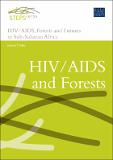| dc.contributor.author | Timko, Joleen | |
| dc.date.accessioned | 2013-03-06T10:13:43Z | |
| dc.date.available | 2013-03-06T10:13:43Z | |
| dc.date.issued | 2011 | |
| dc.identifier.citation | Timko, J. (2011) HIV/AIDS, forests and futures in sub-Saharan Africa, STEPS Working Paper 43, Brighton: STEPS Centre | en_GB |
| dc.identifier.isbn | 9781858649757 | |
| dc.identifier.uri | https://opendocs.ids.ac.uk/opendocs/handle/20.500.12413/2443 | |
| dc.description.abstract | Throughout sub-Saharan Africa, the human immunodeficiency virus/acquired immunodeficiency syndrome (HIV/AIDS) pandemic is having devastating and tragic social, economic, and political impacts. HIV/AIDS is both a health issue and a development problem, with complex links to rural livelihoods, human capacity, and natural resource conservation. As the HIV/AIDS pandemic in Sub-Saharan Africa has spread, it appears that increased pressure has been placed on the already dwindling forest resources on which vulnerable populations depend.
Evidently, forests and the products that they provide may well decrease the vulnerability of rural people by increasing their resilience to HIV/AIDS. Yet, despite decades of research regarding the impacts of HIV/AIDS on rural livelihoods in Sub-Saharan Africa, the links between HIV/AIDS, vulnerability, resilience, and wild natural capital has largely gone unexplored. Research on the interactions between the use of forest resources and contemporary epidemics in general, and on the environmental dimensions of the HIV/AIDS pandemic in particular, remain surprisingly slim. There has been a dearth of research on the contribution of forest products to the livelihoods of HIV/AIDS affected households; the long-term impacts of people living with HIV/AIDS on the management of forest resources; the impacts of forest degradation and deforestation on human health generally, and people affected by HIV/AIDS specifically; the role of the forest industry and its workers in the spread of HIV/AIDS; and the impacts of the disease on the future of forest management institutions and education.
This paper offers a preliminary review and mapping of potential linkages and questions in each of these areas by focusing on three domains of the relationships between HIV/AIDS, forests and forestry: (1) the role of the forest industry (including foresters and truck drivers) in the spread of HIV/AIDS; (2) the interactions between HIV/AIDS-affected households and forest resources; and (3) the impacts of HIV/AIDS-related morbidity and mortality on the future of forestry and forest management institutions. | en_GB |
| dc.description.sponsorship | ESRC | en_GB |
| dc.language.iso | en | en_GB |
| dc.publisher | STEPS Centre | en_GB |
| dc.relation.ispartofseries | STEPS Working Paper;No.43 | |
| dc.rights.uri | http://creativecommons.org/licenses/by-nc-nd/3.0/ | en_GB |
| dc.subject | Agriculture | en_GB |
| dc.subject | Health | en_GB |
| dc.subject | HIV/AIDS | en_GB |
| dc.title | HIV/AIDS, forests and futures in sub-Saharan Africa | en_GB |
| dc.type | Series paper (IDS) | en_GB |
| dc.identifier.koha | 214365 | |


